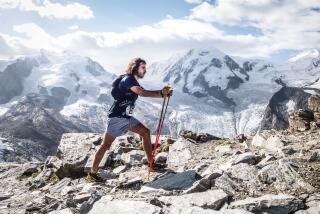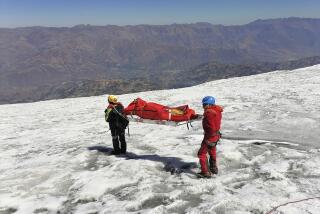Because They Are There : Few Climbers Have Bagged as Many Peaks as Lawyer Doug Mantle, and He Is Only One Away From Another Milestone: the Seven Summits
- Share via
Some collect stamps in their spare time; others collect baseball cards, ceramic figurines or Elvis memorabilia, and some people, such as Doug Mantle, collect mountain peaks.
Mantle, 42, a senior partner in the Southland law firm of Mantle & Callister, has spent the majority of his weekends and vacation days for the last 22 years climbing mountains in California and around the world. No one keeps official records for the most total peaks bagged by an individual--mountaineering jargon for climbing to a summit, usually by the handiest route possible. But if they did, Mantle might find himself near the top of the list.
Mantle estimates that he has made more than 1,000 summit climbs in the Sierra Nevada alone, a figure that is confirmed by officers of the Sierra Club’s Angeles Chapter, of which Mantle is a longtime member. The group has devised three lists of peaks intended to be used as “lifetime” climbing goals: 247 scattered across the Sierra Nevada, 270 of more than 5,000 feet in Southern California and 97 more in the California desert. Mantle has climbed all the peaks on all three lists--three times each--and is now halfway through a fourth go-round.
“Kind of silly, isn’t it?” he said. “But it’s really a good escape from law and that sort of thing.”
Duane McRuer, a former officer of the Angeles Chapter who recently returned from an honorary professorship at MIT, said: “The ‘triple-triple’ is an outstanding achievement. No one else has ever climbed all three of those lists twice before, let alone three times. (Mantle) has also been given the Angeles Chapter’s highest leadership award, the Chester Versteeg Award, for leading a large number of trips and doing it superbly well.”
Mantle’s self-described compulsion to climb mountains has often carried him to exotic locales. He has climbed the Mountains of the Moon in Uganda, Mt. Cook in New Zealand, Mt. Chimborazo and Mt. Cotopaxi in Ecuador and Mt. Huascar in Peru. On other excursions, he scaled Mt. Ararat in Turkey and the Matterhorn, Weisshorn, Mont Blanc and several other peaks in the Alps.
Mantle, a Van Nuys native and a product of UCLA and USC’s law school, is now in position to dwarf his record in the California mountains by achieving the ultimate in peak bagging--the Seven Summits. That consists of scaling the highest peak on each of the seven continents, a feat that has been been accomplished by about 20 climbers. After successful ascents of Mt. Everest in the Himalayas and Antarctica’s Mt. Vinson last year, Mantle has climbed six of the seven.
Mantle’s friends marvel at his stamina and lung power. Randall Danta, who has been climbing with Mantle since the mid-1970s and who made the summit of Everest with him last spring, said: “There’s nobody who can keep up with him. His sheer power is amazing. He’s so fast that he can go into the mountains and complete two or three 13,000-plus peaks in a day, where someone else would be happy to do one. Often just for fun, he’ll be with a group of people in the back, and just to challenge himself, he’ll motor past everyone and be sitting on the summit eating a snack when everyone else starts arriving.”
Longtime Sierra mountaineering guide John Fischer said: “That sounds like your classic, dedicated-for-sure peak bagger.”
Purists of the sport look down on such peak collecting as being in the wrong spirit, according to Fischer, who added: “But of course, someone who does that kind of thing has to be in excellent condition, and also has to be a very skilled mountaineer--not necessarily an expert technical climber, but extremely competent at the basic level of mountaineering skills.”
Mantle said he never actually set out to climb the Seven Summits, an exceptionally difficult, expensive and sometimes perilous hobby. He explained that after he had climbed four of the seven--20,320-foot Mt. McKinley in Alaska, 19,340-foot Kilimanjaro in Tanzania, 18,510-foot Elbrus in Russia and 22,834-foot Aconcagua in Argentina--friends started asking him when he was going to climb the other three.
“The Seven Summits never occurred to me because (I never thought) I would do Everest,” Mantle said. “It seemed like some impossible thing that the big-time expeditioners did, not professional people who have climbing for an avocation.”
But in 1991, Mantle received a letter from highly regarded New Zealand mountaineering guides Rob Hall and Gary Ball inviting him to be part of a spring 1992 expedition to scale Everest. The attorney decided to shell out the $35,000 fee to join the expedition up the 29,028-foot mountain.
“We went up the South Col, Sir Edmund Hillary’s original ascent route,” Mantle said. “While we were there, a couple of people were killed, which was tragic because our guides had just warned them the day before that the mountain wasn’t ready for climbing. One of them got to within 100 yards of the South Col, but he died on the spot from hypothermia and exhaustion. Another one of the fellows didn’t get that far. They were frozen in place there, and one of the other teams had to get them off the mountain because Sherpas don’t go near dead bodies.”
Mantle and other expedition members praised Hall and Ball, who used their own method to acclimatize team members to prevent altitude sickness, a common and sometimes deadly problem on Everest.
“We went up high and came back down six times just getting ready,” Mantle said. “Before the final ascent, we went all the way from 25,500 to 22,000, then down to 14,000 feet to get a little extra oomph. And we were far superior to an American expedition that had just about the same number of people with the same background and time frame. They wound up with a good number of people quite sick and quite a number less making the summit.”
Mantle said that in the process of acclimatizing, they made several traverses through the Khumbu icefall, one of the most dangerous sections of the climb.
“It’s this maze of ice blocks that are always creaking, groaning and moving, and you have to follow a very circuitous route through it,” Mantle said. “Most of the deaths on Everest have occurred there. Imagine a pile of gigantic ice cubes, tipped up until they’re just about ready to fall over--that’s the icefall.’
After five weeks of acclimatizing and waiting, Mantle said, a window of “fabulous” weather developed. The group spent a couple of days at Camp 3, about 24,500 feet, before finally crossing the yellow band of rock that marks the final leg of the ascent.
“We set out in the middle of the night thinking we would never get there. Then we thought finally we had it made when we got to the South Summit, and then we saw the Hillary Step--a section of rock that is close to vertical and looks impossible. When I saw that I said to myself, ‘I’m not going to make it.’ The whole group was quite discouraged. But the leaders told us to take heart, it’s not as bad as it looks, just hold onto some of the ropes placed in there. So we did that and went right on up to the summit.”
Although climbing Mt. Everest would have contented most climbers for a while, Mantle followed that with another potentially dangerous ascent only seven months later. He joined Hall and Ball again on an expedition to scale Antarctica’s highest point, 16,864-foot Mt. Vinson. The price tag this time: $24,500.
Vinson actually is not difficult from a mountaineering standpoint, but Antarctica’s extreme and unpredictable weather can present serious obstacles. Soon after they touched down, Mantle’s group encountered a returning expedition that had run into trouble.
“One man had a very badly frostbitten nose,” Mantle said. “It had turned black and was kind of hanging down. Their expedition had gotten to within 100 meters of the summit in terrible weather, but no farther, and they were coming out. This didn’t sound real good.”
However, as on Everest, Mantle’s team was extremely lucky with the weather.
“We had just sort of figured on being miserable, but it actually wasn’t as bad as we had planned on. The weather was considerably better than it had been a few days earlier, probably about zero degrees Fahrenheit.”
The good weather held, allowing them to reach the summit with relative ease in three days. Mantle described the view from Vinson’s summit as the most spectacular in the world.
“There were a whole series of peaks stretching out into the distance, and on the horizon the polar icecap itself,” he said. “Just a very strange and wonderful scene--different shades of white, like a fairy-tale world of snow and ice.”
On some of his trips, Mantle said, the mountaineering was the easy part.
“On the trip to Russia to climb Mt. Elbrus in 1991,” he said, “as our plane took off to go to the mountain, the coup occurred. The whole time we were in the mountains, our guides were expressing a certain amount of concern about what was going on back in Moscow. As we were climbing, we were thinking, ‘Will I ever be getting out of this country?’ It was kind of scary. But by the time we got back to Moscow, it was over and Gorbachev had been reinstated. We were able to spend a day with the crowds in the streets.”
Mantle needs only one more peak to complete the Seven Summits, but it could be a tricky one. It used to be that 7,310-foot Mt. Kosciusko, the tallest peak in Australia, was considered one of the Seven Summits. Then someone decided it was too easy, and now, some say that the feat is only complete when all of Australasia is included, which means climbing 16,500-foot Mt. Carstensz in New Guinea, a more difficult and perilous journey.
“Plan A is to do Kosciusko,” Mantle said, “but I’m exploring the possibilities of New Guinea.
“Hall and Ball are looking into that now. There are only two ways to do it. One is through a mining company, and they simply refuse permission to cross their territory. The other is a five-day trek through thick jungle, and I’m told there are cannibals. A group of four disappeared there in 1987. I’m definitely interested in Carstensz, though, so I’ll get around to that eventually.”
The Seven Summits
Summit Elev. (Feet) Continent Everest 29,028 Asia Aconcagua 22,834 South America McKinley 20,320 North America Kilimanjaro 19,340 Africa Elbrus 18,510 Europe Vinson 16,864 Antarctica Kosciusko* 7,310 Australia
* Mt. Carstensz, at 16,500 feet in New Guinea, is considered by some to be the seventh summit by including Australia in a larger continental grouping, Australasia.
More to Read
Sign up for The Wild
We’ll help you find the best places to hike, bike and run, as well as the perfect silent spots for meditation and yoga.
You may occasionally receive promotional content from the Los Angeles Times.






